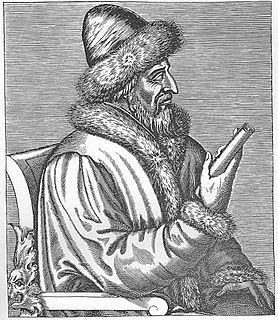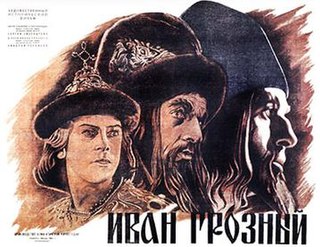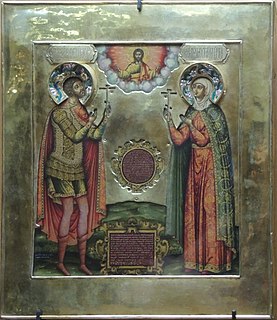
Boris Fyodorovich Godunov ruled the Tsardom of Russia as de facto regent from c. 1585 to 1598 and then as the first non-Rurikid tsar from 1598 to 1605. After the end of his reign Russia descended into the Time of Troubles.

Vasili III Ivanovich was the Grand Prince of Moscow from 1505 to 1533. He was the son of Ivan III Vasiliyevich and Sophia Paleologue and was christened with the name Gavriil (Гавриил). He had three brothers: Yuri, born in 1480, Simeon, born in 1487 and Andrei, born in 1490, as well as five sisters: Elena, Feodosiya, another Elena, another Feodosiya and Eudoxia. He is sometimes mockingly referred to as Vasili the Adequate due to his rule taking place between those of Ivan the Great and Ivan the Terrible, as well as the relative uneventfulness of his reign.

Fyodor I Ivanovich or Feodor I Ioannovich ; 31 May 1557 – 16 January (NS) 1598), also known as Feodor the Bellringer, was the last Rurikid Tsar of Russia (1584–1598).

The Moscow Kremlin, or simply the Kremlin, is a fortified complex in the center of Moscow, overlooking the Moskva River to the south, Saint Basil's Cathedral and Red Square to the east, and the Alexander Garden to the west. It is the best known of the kremlins and includes five palaces, four cathedrals, and the enclosing Kremlin Wall with Kremlin towers. In addition, within this complex is the Grand Kremlin Palace that was formerly the Tsar's Moscow residence. The complex now serves as the official residence of the President of the Russian Federation and as a museum with 2,746,405 visitors in 2017.

Zoe Palaiologina, who later changed her name to Sophia Palaiologina, was a Byzantine princess, member of the Imperial Palaiologos family by marriage, Grand Princess of Moscow as the second wife of Grand Prince Ivan III. Through her eldest son Vasili III, she was also the grandmother of Ivan the Terrible, the first Tsar of All Russia.

Söyembikä was a Tatar ruler, xanbikä. She served as regent of Kazan during the minority of her son from 1549 until 1551.

Anastasia Romanovna Zakharyina-Yurieva was the first spouse of the Russian Tsar Ivan the Terrible and the first Russian Tsaritsa. She was the mother of Feodor I, the last lineal Rurikid Tsar of Russia and the great-aunt of Michael I of Russia, the first Tsar of the Romanov dynasty. Her parents were Boyar Roman Yurievich Zakharyin-Yuriev, Okolnichi, who died on 16 February 1543, who gave his name to the Romanov dynasty of Russian monarchs, and Uliana Ivanovna, who died in 1579.
Dmitry Ivanovich is an appellation composed of the given name and patronymic.

Elena Vasilyevna Glinskaya was a Russian regent. She was Grand Princess consort of Moscow as the second wife of Grand Prince Vasili III and regent of Russia for 5 years (1533–38).

Vladimir Andreyevich was the last appanage Russian prince. His complicated relationship with his cousin, Ivan the Terrible, was dramatized in Sergei Eisenstein's movie Ivan the Terrible.

Ivan the Terrible is a two-part historical epic film about Ivan IV of Russia, written and directed by the filmmaker Sergei Eisenstein. It was commissioned by Soviet Premier Joseph Stalin, who admired and identified himself with Ivan.

Maria Temryukovna was a Circassian Tsaritsa of the Tsardom of Russia and second spouse to Ivan IV of Russia.
Philipp Schall von Bell was the commander-in-chief (Landmarschall) of the Livonian Order forces during the first two years of the Livonian War (1558–1583). Von Bell was taken prisoner after the disastrous Battle of Ergeme and executed by tsar Ivan IV of Russia.

Agafya Semyonovna Grushetskaya - Gruszecki was a Russian noble, Tsaritsa of Russia as the first spouse of Tsar Feodor III of Russia who hailed from the Grushetsky - Gruszecki family.

Blessed Be the Host of the Heavenly Tsar, also known as the Ecclesia militans, is a grand Russian Orthodox icon commemorating the conquest of Kazan by Ivan IV of Russia (1552).

The Episcopal Chamber is a 15th-century monument located in Novgorod Kremlin, Veliky Novgorod, Russia. It is an exceptional example of Gothic architecture in Russia, and included in the UNESCO World heritage list, along with other historic buildings in the city.
Eudoxia Saburova, was a Russian noblewoman, Tsesarevna of Russia as the first spouse of Tsarevich Ivan Ivanovich of Russia, son of Ivan the Terrible.

Ivan the Terrible and His Son Ivan on 16 November 1581 is a painting by Russian realist artist Ilya Repin made between 1883 and 1885. The picture portrays a grief-stricken Ivan the Terrible cradling his mortally wounded son, the Tsarevich Ivan Ivanovich. The elder Ivan himself is believed to have dealt the fatal blow to his son.














